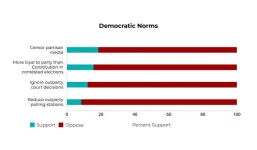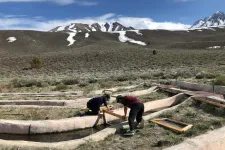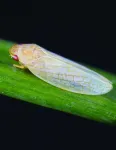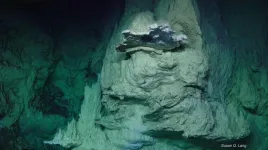(Press-News.org) Blue Carbon projects are expanding globally; however, demand for credits outweighs the available credits for purchase.
Currently, only three types of wetlands are considered Blue Carbon ecosystems: mangroves, saltmarsh and seagrass.
However, other tidal wetlands also comply with the characteristics of what is considered Blue Carbon, such as tidal freshwater wetlands, transitional forests and brackish marshes.
In a new study, scientists from Australia, Indonesia, Singapore, South Africa, Vietnam, the US and Mexico have highlighted the increasing opportunities for Blue Carbon projects for the conservation, restoration and improved management of highly threatened wetlands.
Led by Griffith University’s Dr Fernanda Adame, from the Australian Rivers Institute, the team compiled information on the biophysical characteristics of various tidal wetlands and their managing potential, and concluded that all wetlands below the highest astronomical tide, directly or indirectly influenced by tides, should be classified as blue carbon ecosystems.
“By recognising and prioritising their protection and restoration, we can unlock myriad benefits, including biodiversity conservation,” she said.
"Our research provides compelling evidence that tidal wetlands, beyond mangroves, saltmarshes, and seagrass, exhibit characteristics aligned with Blue Carbon.
"These ecosystems store significant amounts of carbon dioxide in their soils and aboveground biomass, while emitting low levels of greenhouse gases."
Blue carbon projects, centred around the management of mangroves, saltmarshes, and seagrass, have garnered attention for their ability to enhance carbon sequestration and reduce greenhouse gas emissions.
Coastal wetlands in particular have emerged as critical players in the fight against climate change, offering promising opportunities to mitigate atmospheric greenhouse gases.
“By managing these ecosystems strategically, not only can we reduce curb emissions, but we can also make significant strides towards achieving the United Nations Sustainable Development Goals,” Dr Adame said.
By incorporating all tidal wetlands into blue carbon initiatives, we can maximize their potential as carbon sinks and fortify our efforts in combating climate change.
“This inclusive approach not only safeguards our environment but also offers opportunities for sustainable development and conservation.”
The paper ‘All tidal wetlands are blue carbon ecosystems’ has been published in BioScience.
Blue Carbon projects are expanding globally; however, demand for credits outweighs the available credits for purchase.
Currently, only three types of wetlands are considered Blue Carbon ecosystems: mangroves, saltmarsh and seagrass.
However, other tidal wetlands also comply with the characteristics of what is considered Blue Carbon, such as tidal freshwater wetlands, transitional forests and brackish marshes.
In a new study, scientists from Australia, Indonesia, Singapore, South Africa, Vietnam, the US and Mexico have highlighted the increasing opportunities for Blue Carbon projects for the conservation, restoration and improved management of highly threatened wetlands.
Led by Griffith University’s Dr Fernanda Adame, from the Australian Rivers Institute, the team compiled information on the biophysical characteristics of various tidal wetlands and their managing potential, and concluded that all wetlands below the highest astronomical tide, directly or indirectly influenced by tides, should be classified as blue carbon ecosystems.
“By recognising and prioritising their protection and restoration, we can unlock myriad benefits, including biodiversity conservation,” she said.
"Our research provides compelling evidence that tidal wetlands, beyond mangroves, saltmarshes, and seagrass, exhibit characteristics aligned with Blue Carbon.
"These ecosystems store significant amounts of carbon dioxide in their soils and aboveground biomass, while emitting low levels of greenhouse gases."
Blue carbon projects, centred around the management of mangroves, saltmarshes, and seagrass, have garnered attention for their ability to enhance carbon sequestration and reduce greenhouse gas emissions.
Coastal wetlands in particular have emerged as critical players in the fight against climate change, offering promising opportunities to mitigate atmospheric greenhouse gases.
“By managing these ecosystems strategically, not only can we reduce curb emissions, but we can also make significant strides towards achieving the United Nations Sustainable Development Goals,” Dr Adame said.
By incorporating all tidal wetlands into blue carbon initiatives, we can maximize their potential as carbon sinks and fortify our efforts in combating climate change.
“This inclusive approach not only safeguards our environment but also offers opportunities for sustainable development and conservation.”
The paper ‘All tidal wetlands are blue carbon ecosystems’ has been published in BioScience.
END
Alternative tidal wetlands in plain sight overlooked Blue Carbon superstars
2024-03-18
ELSE PRESS RELEASES FROM THIS DATE:
The majority of Americans do not support anti-democratic behavior, even when elected officials do
2024-03-18
EMBARGOED UNTIL MARCH 18 AT 3 P.M. EST
Recently, fundamental tenets of democracy have come under threat, from attempts to overturn the 2020 election to mass closures of polling places.
A new study from the Polarization Research Lab, a collaboration among researchers at the Annenberg School for Communication at the University of Pennsylvania, Dartmouth College, and Stanford University, has found that despite this surge in anti-democratic behavior by U.S. politicians, the majority of Americans oppose anti-democratic attitudes and reject partisan violence.
From September 2022 to October 2023, a period which included the 2022 midterm ...
Genes identified that allow bacteria to thrive despite toxic heavy metal in soil
2024-03-18
VANCOUVER, Wash. -- Some soil bacteria can acquire sets of genes that enable them to pump the heavy metal nickel out of their systems, a study has found. This enables the bacteria to not only thrive in otherwise toxic soils but help plants grow there as well.
A Washington State University-led research team pinpointed a set of genes in wild soil bacteria that allows them to do this in serpentine soils which have naturally high concentrations of toxic nickel. The genetic discovery, detailed in the journal Proceedings of the National Academies ...
Scientists’ discovery could reduce dependence on animals for vital anti-blood clot drug
2024-03-18
Heparin, the world’s most widely used blood thinner, is used during procedures ranging from kidney dialysis to open heart surgery. Currently, heparin is derived from pig intestines, but scientists at Rensselaer Polytechnic Institute have discovered how to make it in the lab. They have also developed a path to a biomanufacturing process that could potentially revolutionize how the world gets its supply of this crucial medicine.
“In recent years, with disease and contamination issues disrupting the global supply chain of pig heparin and potentially putting millions of patients at risk, it’s clear we need to diversify ...
Artificial streams reveal how drought shapes California’s alpine ecosystems
2024-03-18
Berkeley — A network of artificial streams is teaching scientists how California’s mountain waterways — and the ecosystems that depend on them — may be impacted by a warmer, drier climate.
Over the next century, climate change is projected to bring less snowfall to the Sierra Nevada. Smaller snowpacks, paired with warmer conditions, will shift the annual snowmelt earlier into the year, leaving less water to feed streams and rivers during the hot summer months. By 2100, mountain streams are predicted to reach their annual base, or “low-flow,” conditions an average of six ...
Not in my backyard? Wind turbines have little effect on US property values
2024-03-18
“The impact of wind turbines on house prices is much smaller than generally feared: In the U.S., it’s about one percent for a house that has at least one wind turbine in a 10 km radius”, explains Maximilian Auffhammer, a Professor in the Department of Agricultural and Resource Economics at the University of California, Berkeley and co-author of the study. “And what really surprised me is that the house value bounces back to the original price over the years.” The study authors also found that there was no longer any ...
The costs of a changing landscape
2024-03-18
UNDER EMBARGO UNTIL MARCH 18, 2024 AT 3:00 PM U.S. EASTERN TIME
Renewable energy sources are essential for transitioning towards a decarbonized energy system and making the electricity grid more environmentally sustainable. Clean energy alternatives like wind power can effectively replace fossil fuels, contributing to reduced air pollution and slow down climate change.
Wind power has emerged as the fastest-growing non-hydro renewable energy source worldwide. However, the implementation of wind energy infrastructure, including windmills, faces significant challenges. One major obstacle is the opposition from local communities.
Wind turbines, the primary ...
UMD researchers develop genomic method of monitoring for pesticide resistance
2024-03-18
Farmers rely on pesticides to control agricultural pests. But insects often develop resistance to the toxins in pesticides. University of Maryland researchers have developed and successfully tested a strategy for using genomics to monitor for and identify emerging resistance to specific toxins early, well before it becomes a widespread problem. The work will enable farmers to mitigate resistance and prolong the effectiveness of pest management tools.
The research was published on March 18, 2024, in the Proceedings of ...
Backyard insect inspires invisibility devices, next gen tech
2024-03-18
UNIVERSITY PARK, Pa. — Leafhoppers, a common backyard insect, secrete and coat themselves in tiny mysterious particles that could provide both the inspiration and the instructions for next-generation technology, according to a new study led by Penn State researchers. In a first, the team precisely replicated the complex geometry of these particles, called brochosomes, and elucidated a better understanding of how they absorb both visible and ultraviolet light.
This could allow the development of bioinspired optical materials with possible applications ranging from invisible cloaking devices to coatings to more efficiently harvest ...
Americans support democratic norms, elected officials don't
2024-03-18
Following the attack on the U.S. Capitol on Jan. 6, 2021, and efforts to overturn the results of the 2020 presidential election, many Americans have raised concerns about the future of democracy in the United States.
Yet the American public, including Democrats and Republicans alike, strongly oppose anti-democratic actions and partisan violence, according to a new study by the Polarization Research Lab.
"Democracy is under threat in America, but these data show we are not on the brink of a citizen-supported push toward authoritarianism," says the lab's ...
Harnessing hydrogen at life’s origin
2024-03-18
A new report uncovers how hydrogen gas, the energy of the future, provided energy in the past, at the origin of life 4 billion years ago. Hydrogen gas is clean fuel. It burns with oxygen in the air to provide energy with no CO2. Hydrogen is a key to sustainable energy for the future. Though humans are just now coming to realize the benefits of hydrogen gas (H2 in chemical shorthand), microbes have known that H2 is good fuel for as long as there has been life on Earth. Hydrogen is ancient energy. The very first cells on Earth lived from H2 produced in hydrothermal vents, using the reaction of H2 with CO2 to make the molecules of ...




